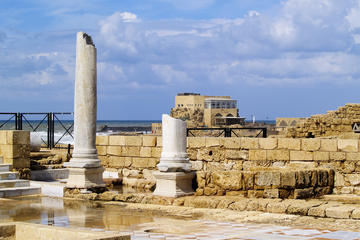
Caesarea
About 2,000 years ago, Israel’s beautiful fishing port of Caesarea was a Roman capital, dedicated to Caesar Augustus. Today, it is one of the country’s most popular tourist sites, with archaeological ruins, beautiful beaches and an impressive Roman theater.
Caesarea was built by Herod the Great over 12 years, from 25-13 BC, and was one of the grandest cities in the area with a deep sea harbor, aqueduct, hippodrome and amphitheater, which is still utilized today. The site holds concerts and other performances, while the hippodrome, although still identifiable, is now a banana field. It is smaller than the Circus Maximus in Rome but still held 20,000 spectators for chariot races at one point.
Caesarea’s harbor is an engineering marvel with both an inner and outer area. It was constructed using hydraulic concrete to create breakwaters. Caesarea Aqueduct Beach, on the other hand, is considered one of the best beaches in Israel. As its name suggests, there is an ancient aqueduct marking its edge.
If you are interested in museums, Philanthropist Harry Recanti founded the city’s Ralli Museum, which includes galleries that focus on Latin American and Sephardic Jewish artwork. The city even boasts an underwater museum, where visitors can dive through ancient ruins.
Practical Info
Caesarea is located mid-way between Tel Aviv and Haifa, near the city of Hadera. There is an entry fee to Caesarea National Park, and getting to the area via public transportation can be difficult. Most visitors to Caesarea book organized tours from cities like Jerusalem, as it’s the most efficient transportation method. If you plan to lounge on the beach, take note there is no lifeguard on duty.
